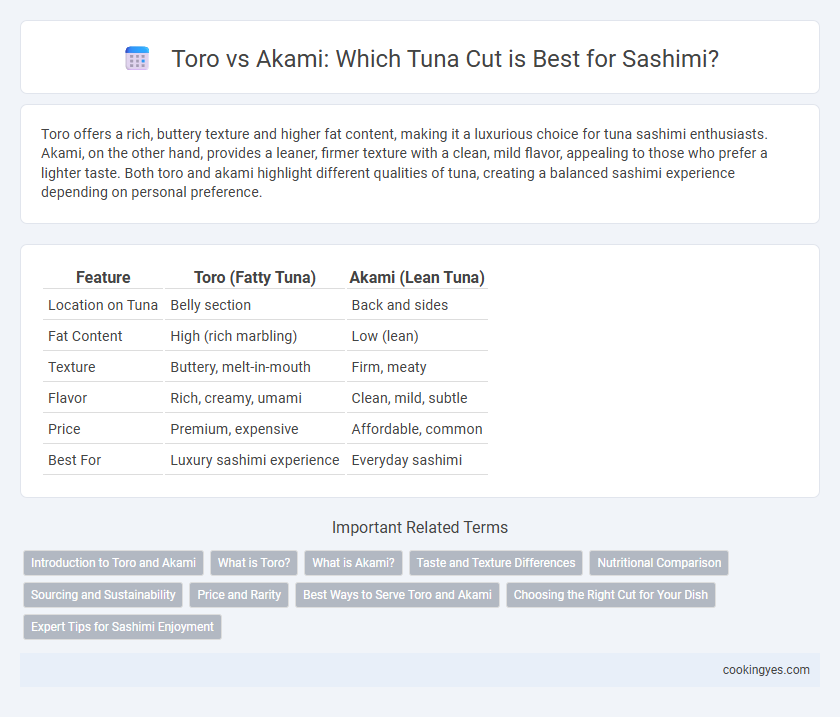Toro offers a rich, buttery texture and higher fat content, making it a luxurious choice for tuna sashimi enthusiasts. Akami, on the other hand, provides a leaner, firmer texture with a clean, mild flavor, appealing to those who prefer a lighter taste. Both toro and akami highlight different qualities of tuna, creating a balanced sashimi experience depending on personal preference.
Table of Comparison
| Feature | Toro (Fatty Tuna) | Akami (Lean Tuna) |
|---|---|---|
| Location on Tuna | Belly section | Back and sides |
| Fat Content | High (rich marbling) | Low (lean) |
| Texture | Buttery, melt-in-mouth | Firm, meaty |
| Flavor | Rich, creamy, umami | Clean, mild, subtle |
| Price | Premium, expensive | Affordable, common |
| Best For | Luxury sashimi experience | Everyday sashimi |
Introduction to Toro and Akami
Toro and Akami represent two distinct cuts of tuna prized in sashimi cuisine, each offering unique flavor and texture profiles. Toro, derived from the fatty belly of the tuna, is celebrated for its rich, buttery texture and high fat content, delivering a melt-in-the-mouth experience. Akami, taken from the leaner red meat of the tuna, provides a firmer texture with a clean, robust flavor ideal for those who prefer a subtler, less fatty sashimi option.
What is Toro?
Toro is the fatty belly portion of the tuna, prized for its rich marbling and buttery texture that melts in the mouth. It contrasts with Akami, the leaner, red meat from the tuna's sides, which offers a firmer texture and more pronounced flavor. High-quality Toro, especially from Bluefin tuna, is sought after in sushi cuisine for its delicate balance of fat content and subtle sweetness.
What is Akami?
Akami is the lean, red meat from the sides of the tuna, prized for its firm texture and deep umami flavor. It contrasts with Toro, the fatty belly portion, by offering a cleaner taste and lower fat content. Akami is commonly used in sashimi for its vibrant color and satisfying bite, making it a favorite among purists seeking authentic tuna flavor.
Taste and Texture Differences
Toro sashimi, sourced from the fatty belly of the tuna, offers a rich, buttery flavor profile and a melt-in-the-mouth texture due to its high fat content. Akami, taken from the leaner red meat portion, presents a firmer texture with a clean, mild taste that highlights the freshness of the fish. The contrast between Toro's creaminess and Akami's firmness creates distinct sensory experiences sought by sushi and sashimi enthusiasts.
Nutritional Comparison
Toro and Akami are two popular cuts of tuna used in sashimi, offering distinct nutritional profiles. Toro, derived from the fatty belly of the tuna, contains higher levels of omega-3 fatty acids and calories due to its rich fat content, which supports heart health and cognitive function. Akami, the leaner part of the tuna, is lower in fat and calories but provides a higher concentration of protein and essential vitamins such as B12, making it ideal for those seeking a nutrient-dense, low-fat option.
Sourcing and Sustainability
Toro and Akami represent two distinct cuts of tuna sashimi valued differently for their texture and flavor; Toro is the fatty belly portion, while Akami is the leaner meat from the sides. Sourcing Toro often involves premium Bluefin tuna, a species under significant sustainability pressure, prompting increasing reliance on responsibly farmed or MSC-certified tuna to meet ethical standards. Akami typically comes from more abundant species like Yellowfin or Bigeye, allowing for more sustainable sourcing practices that help reduce overfishing risks while maintaining high-quality sashimi.
Price and Rarity
Toro, known as the fatty belly portion of tuna, commands a significantly higher price due to its rich marbling and scarcity compared to Akami, the leaner, more abundant red meat from the tuna's sides. The rarity of Toro, especially Otoro (the fattiest part), elevates its market value, making it a luxury item in sushi and sashimi dining. In contrast, Akami is more widely available and affordable, favored for its firm texture and clean taste, presenting a cost-effective option without sacrificing quality.
Best Ways to Serve Toro and Akami
Toro and Akami represent two premium cuts of tuna used in sashimi, with Toro prized for its rich, fatty texture and Akami known for its firm, lean quality. Serving Toro best involves slicing it thinly to highlight its melt-in-the-mouth fat content, often paired with light soy sauce or ponzu to balance its richness. Akami shines when served slightly thicker, allowing its robust umami flavor to stand out, frequently complemented by wasabi and grated ginger to enhance its clean taste.
Choosing the Right Cut for Your Dish
Toro and Akami represent two distinct tuna sashimi cuts, each offering unique flavors and textures tailored to different dishes. Toro, the fatty belly portion, provides a rich, buttery taste and tender mouthfeel ideal for indulgent, melt-in-the-mouth sashimi experiences. Akami, the lean red muscle, delivers a clean, robust flavor with a firmer texture, making it a versatile choice suited for lighter preparations or those seeking a balanced tuna flavor.
Expert Tips for Sashimi Enjoyment
Toro, the fatty belly cut of tuna, offers a rich, buttery texture that melts in your mouth, while Akami, the leaner back portion, provides a firm and clean flavor profile ideal for those who prefer a more delicate taste. Experts recommend pairing Toro sashimi with lighter soy sauce or a touch of yuzu to enhance its natural sweetness, whereas Akami benefits from a bit of wasabi to highlight its subtle umami notes. For optimal sashimi enjoyment, slice Toro slightly thicker to appreciate its marbling and serve Akami chilled to preserve its fresh, vibrant taste.
Toro vs Akami for tuna sashimi Infographic

 cookingyes.com
cookingyes.com